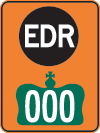|
EDR signs line hwys 401, 402, 403 (con't)
They direct traffic on to nearby major highways that run parallel to the 401. The signs are also on major freeways in the rest of the province and the ministry “continues to work with other municipalities to look at future opportunities for other EDR locations,” Nichols said. The first signs were actually installed in 2004. Nichols said the ministry worked with a variety of groups to come up with the signs and routes. These included the Ontario Good Roads Association, the OPP, local police and municipal representatives. “EDRs provide a pre-determined route for travellers in situations where the OPP must make an emergency full closure on a provincial highway,” Nichols said. “A full closure is required to manage, investigate, clean-up or facilitate repairs following a traffic incident, or if there is a threatening or potentially dangerous situation, emergency or incident adjacent to the highway,” he added. The ministry says road closures usually last two to three hours. Police or municipal officials might be stationed along the emergency route to help direct traffic. The EDR signs are also placed along the emergency routes and act like construction detour signs. They direct motorists, after several kilometres, back to the main highway and around the reason for the traffic blockage. WindsorOntarioNews.com |





